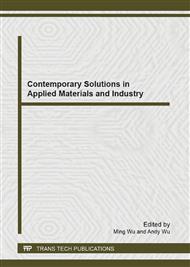p.113
p.119
p.124
p.131
p.137
p.141
p.145
p.149
p.157
A Highly Sensitive Resonance Rayleigh Scattering Method for Platelet-Derived Growth Factor Using Aptamer-Nanogold Probe as Catalyst of the Cu2O Particle Reaction
Abstract:
Using sodium citrate as reducing agent, different sizes of gold nanoparticles(GN) were prepared, and were modified by platelet-derived growth factor (PDGF) aptamer to obtain stable aptamer-nanogold probes (Apt-GN). The probe specifically combined with PDGF-AA to form Apt-GN-PDGF-AA clusters that exhibited a resonance Rayleigh scattering (RRS) peak at 550 nm. The RRS intensity ΔI550nm was linear to the PDGF-AA concentration in the range of 0.33-40 ng/ml. The probe has strong catalysis of the Fehling reagent-glucose Cu2O particle reaction that can be monitored by RRS technique at 610 nm, but the cluster is very weak. When PDGF-AA concentration increased, the Apt-GN decreased, and the RRS intensity at 610 nm decreased. The decreased RRS intensity ΔI610nm was linear to PDGF-AA concentration in the range of 0.03-26.67 ng/mL. Accordingly, two new aptamer-nanogold RRS methods were established.
Info:
Periodical:
Pages:
137-140
Citation:
Online since:
April 2013
Authors:
Price:
Сopyright:
© 2013 Trans Tech Publications Ltd. All Rights Reserved
Share:
Citation:


